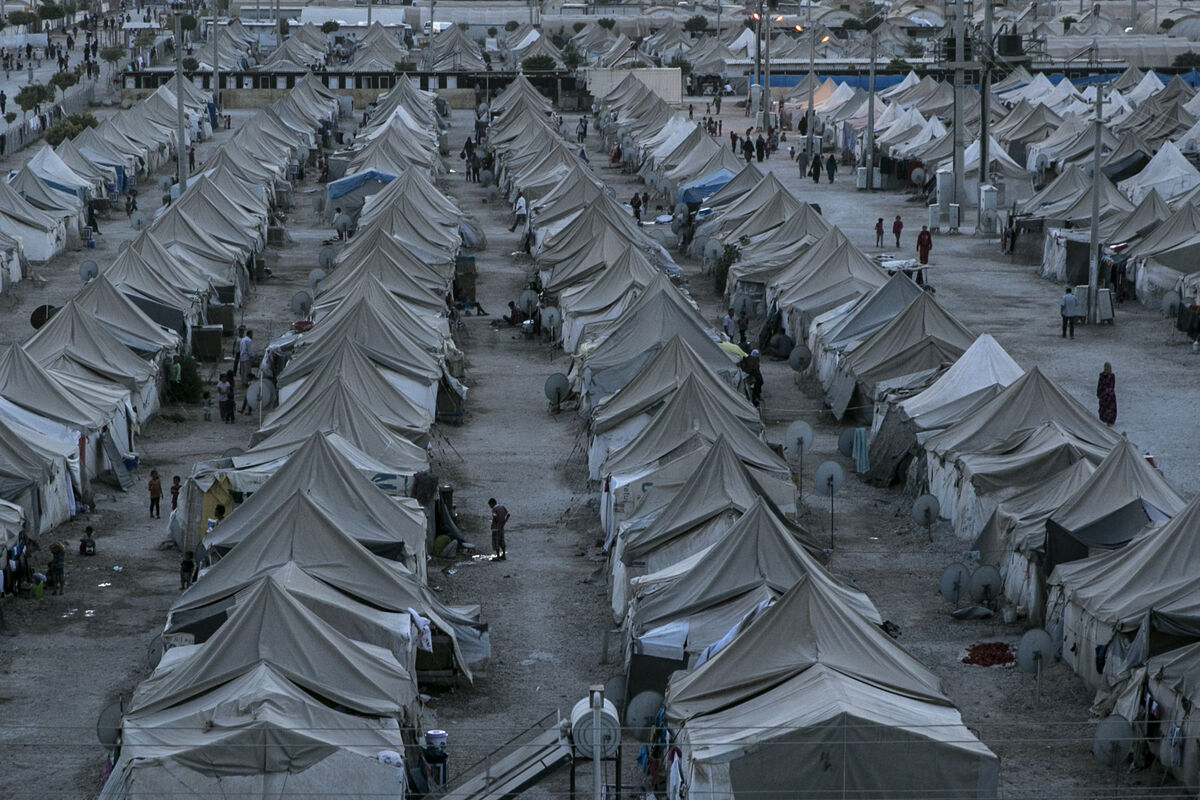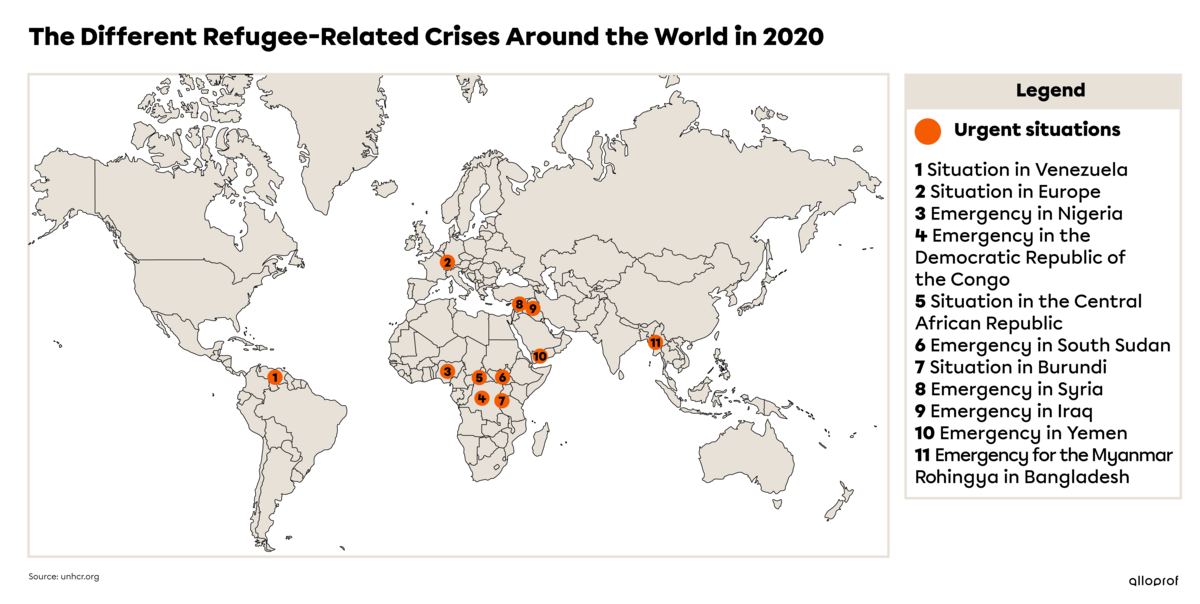Some people leave their country voluntarily, but not everyone does. Some people are driven from their homes in order to survive, meaning migration is unwanted and unplanned.
Refugees are protected by the Geneva Convention Relating to the Status of Refugees. This convention, which was signed in 1951, was updated in 1967. It grants refugees basic rights in countries that receive them. These rights are:
-
The right to safety (right to asylum)
-
Fundamental rights of citizens: freedom of expression, freedom of movement and protection against torture and inhumane treatment
-
Economic and social rights: access to health care, education and jobs
-
A refugee is a person who has been forced to leave their home country to escape a natural disaster, war or persecution that threatens their life and safety.
-
The right to asylum provides protection in a host country to a person whose life is threatened in their own country. This person must request this protection.
People must meet specific criteria to be considered a refugee. People must:
-
be outside the country in which they have citizenship, and if they are stateless and do not have citizenship, they must be outside the country where they usually live;
-
fear persecution based on ethnicity, religion, nationality, membership in a social group, political opinion, war or conflict;
-
be unable to seek protection from their own country and not want to return;
-
see no way to improve their situation in the near future, such as a war that may last several years.
Ines is currently living in a refugee camp in Turkey. She left Syria due to the armed conflict that broke out in 2011. She is afraid that if she returns to her country, she and her family will be at risk. The situation in Syria will likely last for several more years. Since Ines meets many of the criteria, she is granted refugee status.
A stateless person is a person who does not possess the nationality of any country. Because these people are deprived of their nationality, they are also deprived of many of their fundamental rights.

In 2015, this camp was home to some 28 000 Syrians.
Source: Tolga Sezgin , Shutterstock.com
A refugee camp is a temporary facility used to house refugees and provide them with basic supplies and care, such as shelter, food, health care and education.
In 2018, 70.8 million people worldwide were uprooted and forced to leave their homes for one reason or another. Considering that there were 7.44 billion people in the world in 2018, according to the US Census Bureau, this means an estimated 1% of the world’s population left their homes behind.
41.3 million of these people were internally displaced within their own country, 25.9 million were refugees and 3.5 million were asylum seekers. An estimated 80% of refugees live in countries that border their home countries. Refugees mainly originate from Syria, Afghanistan and South Sudan. The main host countries are Germany, Sudan, Uganda, Pakistan and Turkey. On average, 37 000 people are forced to flee conflict and persecution every day.
Filippo Grandi, the UN’s High Commissioner for Refugees, commented on the situation:
“By any measure this is an unacceptable number, and it speaks louder than ever to the need for solidarity and common purpose in preventing and resolving crises and ensuring together that the world’s refugees, internally displaced and asylum seekers are properly protected and cared for while solutions are pursued.”
These various situations impacted 196 705 people in Canada, including 114 109 people who were granted refugee status, 78 806 asylum seekers and 3 790 stateless people.
An asylum seeker is a person seeking protection outside the borders of their country, but whose claim for asylum is still under review.
Several events have caused people to abruptly leave their homes in the past few decades. These include the Cuban Revolution, the Rwandan genocide, the armed conflict in Colombia, the Kosovo War and the War in Darfur.
To find out more about these events, check out the following links:
Let’s look at how the Cuban Revolution created refugees.
Between 1959 and 2015, close to one in eight Cubans left the country to escape Fidel Castro’s communist regime. This led to nearly one million refugees, most of whom decided to settle in the United States. Others moved to Spain, Italy, Puerto Rico, Mexico and Canada.
These departures happened in different waves. The first wave took place when the revolution first started between 1959 and 1962. People who opposed the regime left the country by plane.
A second wave took place from 1965 to 1973. During this time, almost 300 000 Cubans sought refuge in the United States.
The third wave of Cuban refugees began in the early 1980s. This time, it was more dangerous to leave the country. Cubans left the country on makeshift boats and many drowned along the way. Some 125 000 Cuban refugees managed to cross into South Florida.
During the first two waves of immigration, Cubans had a certain freedom of movement that allowed them to leave the country using traditional transportation methods. From the third wave onwards, the borders were closed, so people had to find roundabout ways to get out of the country. People could no longer leave by plane, like during the first two waves.
Crises can take different forms, including wars and natural disasters. These situations cause great suffering and insecurity, because victims usually lose their family members, homes and livelihoods. In 2020, the main issues that caused people to flee their country were:
-
the crisis in Venezuela
-
the crisis in Burundi
-
the crisis in the Democratic Republic of the Congo
-
the crisis for the Rohingya (from Myanmar to Bangladesh)
-
the crisis in Nigeria
-
the crisis in Yemen
-
the crisis in Europe
-
the crisis in the Central African Republic
-
the crisis in Iraq
-
the crisis in South Sudan
-
the crisis in Syria

To learn more about the different crisis situations, visit: Emergencies
The Syrian crisis started in 2011. Since then, 5.6 million Syrians have fled the country and become refugees. In addition to these refugees, 6.6 million people have been internally displaced. Turkey receives 64.5% of Syrian refugees, and many others are in Lebanon, Jordan, Iraq and Egypt. In March 2020, 288 267 Syrians were living in refugee camps.
To obtain refugee status in Canada, applicants must provide information about their background, family and reasons for claiming refugee protection.
The first step is deciding where to apply. There are two options: at an Immigration, Refugees and Citizenship Canada (IRCC) office or at a port of entry such as an airport, seaport or land border crossing.
At an office, applicants must fill out all the application forms and submit them to an officer, who verifies that the application is complete. If it is, an interview date is set. During this interview, the application is reviewed and it is determined whether the applicant is eligible for refugee protection.
At a port of entry, applicants are given the application forms on arrival. The applicant has 15 days to complete the application and submit it to the Refugee Protection Division.
After that, the applicant must appear at an Immigration and Refugee Board of Canada (IRB) hearing. At this hearing, the Commissioner reviews the documents filed in evidence, and the refugee protection claimant gives evidence. Other people can also give their testimony to support the claim. A comment (observation) period follows. Once the hearing is over, the Commissioner may issue a decision on the spot or wait and send the decision by mail.